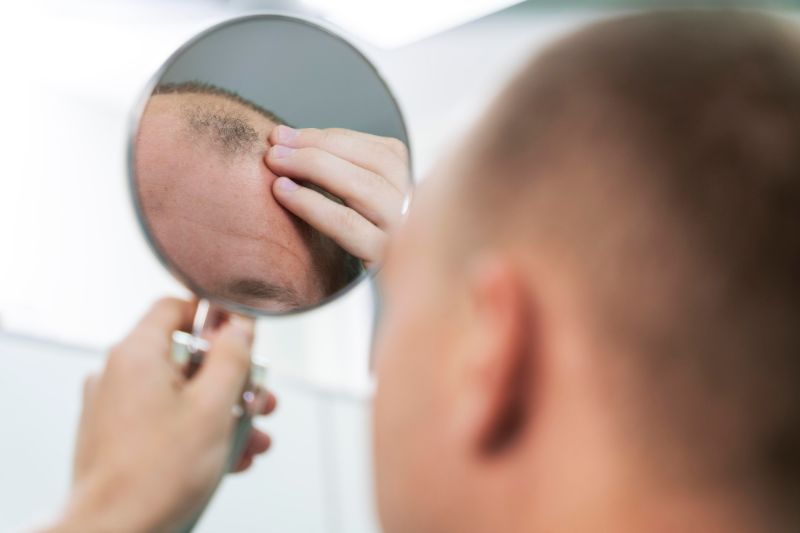What are the different stages of alopecia ?

The different stages of alopecia
Because alopecia is different from one individual to another, it is important to understand what the different stages of alopecia are. This makes it possible to adapt the best treatment to overcome hair loss.
When hair transplantation is used, defining the stage of alopecia is essential in order to diagnose the number of grafts necessary as well as the implantation technique that must be used during the hair transplant operation.
It is of course up to the surgeon to define the stage of alopecia of each patient. But knowing what stage of alopecia we are at is also very useful, and allows us to turn to the most suitable treatment.
So, are you a candidate for hair transplant? Should you opt for another hair treatment? How to define the different stages of alopecia whether male or female? In this article, we explain everything.
What are the different stages of alopecia ?
The 7 different stages of alopecia in men
The different stages of alopecia – As baldness is a phenomenon that affects approximately 9 out of 10 men, understanding and evaluating the progress of alopecia is important. This allows for a preliminary diagnosis.
The degree of alopecia in men is classified according to the Hamilton-Norwood scale, which consists of 7 different stages.
- Moderate alopecia is in stages 1, 2 and 3.
- Average alopecia is in stages 4 and 5.
- Advanced alopecia is in stages 6 and 7.

Moderate male alopecia
At stage 1 on the Hamilton-Norwood scale, the alopecia affects only the entrances (or gulfs), which are located on the sides of the frontal area.
At stage 2, the loss of density at the level of the gulfs is accentuated, and the entrances are hollowed out a little more.
At stage 3, the gulfs are dug and the alopecia begins to affect the crown (or vertex) which also begins to lose density.
The average male alopecia
At stage 4, we can see that the hairline recedes, the entrances are clearly hollowed out and the crown continues to thin out.
At stage 5, the frontal area is even further back and joins the crown. The area at the top of the head is therefore very sparse.
Advanced male alopecia
At stage 6, the hairline is non-existent and the entire top of the head has lost density. At this stage the crown can also descend on the back of the head.
At stage 7, the entire top of the head is balding. No more hair is present, except those at the lower back of the head and on the side areas. At this stage, it happens that a hair transplant is no longer possible.
The 3 stages of alopecia in women
The different stages of alopecia – Alopecia can indeed also affect women. It is a phenomenon that can occur in particular following hormonal changes (pregnancy, menopause)…
The degree of alopecia in women is classified according to the Ludwig scale, which consists of 3 different stages.

Moderate female alopecia
At stage 1 on the Agnès Ludwig scale, the hair on the top of the skull is thinning.
Average female alopecia
In stage 2, the lightening of the hair at the level of the middle parting is accentuated, and the top of the skull is visibly balding.
Advanced female alopecia
In Stage 3, the crown of the head and the middle parting are clearly visible, and these areas have almost no hair left.
How to determine the stage of your alopecia
The different stages of alopecia – In order to know precisely its stage of alopecia, a diagnosis must be established by the hair experts of HairBack Clinic.
Dr. Baykal Oymak studies each patient on a case-by-case basis, and provides a personalized diagnosis.
To do this, you will be asked to send several photos of your skull, in order to be able to define the stages of alopecia.
Thus, a diagnosis specifying the number of grafts, the number of hair transplant sessions and the technique best suited to your case, will be provided to you.
Graft implantation techniques
To date, the 2 most modern and advanced techniques that exist are the FUE Sapphire technique and the DHI technique.
The choice of the implantation technique belongs to the doctor, who carefully analyzes your stage of alopecia, and will guide you towards the technique that will allow you to obtain the best hair transplant result.
Ask for your free diagnosis —> contact
______

Dr. Baykal Oymak is a highly esteemed transplant specialist hailing from Turkey, boasting an impressive 17-year tenure in the medical field. His professional journey commenced as a dermatologist at Bogazici Hospital in Istanbul, where he began to hone his expertise. Since then, Dr. Oymak has conducted a remarkable tally of approximately 14,000 triumphant hair transplant procedures within Turkey. Additionally, he holds specialization in PRP treatment and Mesotherapy, further solidifying his reputation as a versatile and accomplished practitioner in the realm of dermatology and transplantation. » SCHEDULE YOUR HAIR TRANSPLANT IN TURKEY HERE «
